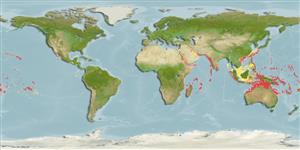>
Perciformes/Serranoidei (Groupers) >
Anthiadidae (Fairy basslets or Streamer basses)
Etymology: Pseudanthias: Greek, pseudes = false + Greek, anthias = a fish, Sparus aurata (Ref. 45335).
Eponymy: Clive Forster Cooper, FRS (1880–1947) was an English palaeontologist. [...] (Ref. 128868), visit book page.
More on author: Regan.
Issue
Ref. 2334 explains the use of current genus name.
Environment: milieu / climate zone / profondeur / distribution range
Écologie
marin récifal; profondeur 10 - 91 m (Ref. 26165), usually 10 - 60 m (Ref. 27115). Tropical; 22°C - 27°C (Ref. 27115); 32°N - 24°S
Indo-Pacific: East Africa to Samoa and the Line Islands (Ref. 2334), north to southern Japan, south to the Great Barrier Reef.
Taille / Poids / Âge
Maturité: Lm ? range ? - ? cm
Max length : 14.0 cm TL mâle / non sexé; (Ref. 2334); common length : 12.0 cm TL mâle / non sexé; (Ref. 9137)
Épines dorsales (Total) : 10; Rayons mous dorsaux (Total) : 15 - 17; Épines anales: 3; Rayons mous anaux: 7 - 8. Males develop an incomplete crimson bar in the middle of their sides (Ref. 37816).
Body shape (shape guide): fusiform / normal; Cross section: compressed.
Mostly found on open substrate with low reef and remote bommies in depths over 20 m. Juveniles maybe shallow in coastal reefs (Ref. 48635). Form small, loose aggregations along current-swept drop-offs (Ref. 1602, 48635).
Life cycle and mating behavior
Maturité | Reproduction | Frai | Œufs | Fécondité | Larves
Masuda, H. and G.R. Allen, 1993. Meeresfische der Welt - Groß-Indopazifische Region. Tetra Verlag, Herrenteich, Melle. 528 p. (Ref. 9137)
Statut dans la liste rouge de l'IUCN (Ref. 130435: Version 2025-1)
Menace pour l'homme
Harmless
Utilisations par l'homme
Pêcheries: commercial; Aquarium: Aquariums publics
Outils
Articles particuliers
Télécharger en XML
Sources Internet
Estimates based on models
Preferred temperature (Réf.
123201): 24.8 - 28.8, mean 27.6 °C (based on 990 cells).
Phylogenetic diversity index (Réf.
82804): PD
50 = 0.5000 [Uniqueness, from 0.5 = low to 2.0 = high].
Bayesian length-weight: a=0.00933 (0.00498 - 0.01748), b=2.93 (2.76 - 3.10), in cm total length, based on LWR estimates for this species & (Sub)family-body (Ref.
93245).
Niveau trophique (Réf.
69278): 3.4 ±0.45 se; based on food items.
Résilience (Réf.
120179): Haut, temps minimum de doublement de population inférieur à 15 mois (Preliminary K or Fecundity.).
Fishing Vulnerability (Ref.
59153): Low vulnerability (10 of 100).
🛈
Nutrients (Ref.
124155): Calcium = 87.9 [49.0, 168.3] mg/100g; Iron = 0.834 [0.450, 1.427] mg/100g; Protein = 18 [16, 20] %; Omega3 = 0.179 [0.109, 0.289] g/100g; Selenium = 30.1 [17.0, 58.0] μg/100g; VitaminA = 195 [68, 632] μg/100g; Zinc = 1.49 [1.00, 2.15] mg/100g (wet weight);
